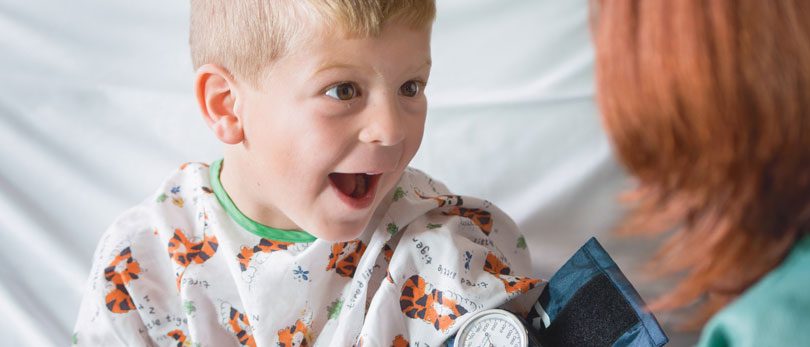A few years ago, Heather Conklin noticed that her 2-year-old son, Aaron, was not chattering away in the same way that his older siblings had at that age. Aaron had lots to say — it was just in his own language, which his family grew to understand.
Then other little problems came to Ms. Conklin’s attention. Certain foods would cause Aaron to gag, and he seemed to be drooling too much for a boy of his age.
Ms. Conklin reported her concerns during her next visit to Aaron’s pediatrician, Mary DeGuardi, MD. Dr. DeGuardi listened attentively to Ms. Conklin’s concerns and, after completing her examination of Aaron, she referred Aaron to the Broome County Early Intervention Program (EIP).
“Aaron was showing signs of a speech delay,” says Dr. DeGuardi. “His failure to produce words as expected for his age, along with the problems with drooling, were signs that a speech evaluation should be done.”
Coordinated Services
Ms. Conklin followed Dr. DeGuardi’s recommendation and took advantage of the Early Intervention Program. The Broome County EIP, which is run through the county’s health department, will pay for certain services if a child under age 3 is found to have special needs in areas ranging from nutrition and physical therapy to vision services and assistive technology. The EIP referred Aaron to Stephanie Williams, MS, CCC-SLP, a speech pathologist at UHS in Binghamton.
Ms. Williams began to work with Aaron to improve his speech, mainly through exercises disguised as play. Just as important, Ms. Williams was able to coordinate services and appointments with other practitioners the Conklins needed.
“We had Aaron evaluated by an otolaryngologist, Dr. John Abdo, to see if there were anatomical reasons for his speech difficulties,” says Ms. Williams. Often children at this young age have large tonsils that interfere with speech and make swallowing difficult. “There are pros and cons to having a tonsillectomy,” says Ms. Williams. “Everyone had to concur that the surgery would be the best course of action for Aaron.”
As it turned out, Dr. Abdo did not recommend surgery. Based on his examination of Aaron and using reports from Aaron’s parents, Ms. Williams, and Dr. DeGuardi, he felt that a wait-and-see approach was best for the youngster, who could very well grow into his tonsils. The risks attendant to surgery, he felt, were not worth it at that early age. Dr. Abdo also performed a hearing evaluation to make sure Aaron’s difficulties weren’t related to a hearing impairment.
A Plan in Place
With a care plan in place, Aaron and his family continued working with Ms. Williams. “Our main goal was communication,” says Ms. Williams. “Early on, we worked on speech sounds. We also used pictures, a system of gestures and some American Sign Language, all so Aaron could communicate effectively and without frustration.” Some of Aaron’s exercises included imitating sounds, looking in the mirror while he ate, putting his tongue in specific places while speaking, and even chewing gum.
“We all had homework. As he improved, we all had to insist that Aaron use the proper words for things at home. And his older brothers had to stop using Aaron’s words for things. His brothers went to therapy, too.”
—Heather Conklin
Aaron also participated in large-motor activities such as jumping on a trampoline and playing on swings and slides. His excitement at play was therapeutic. “His laughter when he was jumping on the trampoline was communication,” says Ms. Williams. “Asking for ‘more’ [time on the slide] was communication.” She offers that it is great that UHS has so many tools and such a great space to treat youngsters.
STEADY IMPROVEMENT
For the first year, one of Aaron’s parents was in the sessions with him and Ms. Williams while the other watched from an adjacent observation room. “I saw Aaron for only two hours a week in his first year,” says Ms. Williams, which left the rest of the week’s exercises in the family’s hands.
“We all had homework,” says Ms. Conklin. “As he improved, we all had to insist that Aaron use the proper words for things at home. And his older brothers had to stop using Aaron’s words for things. His brothers went to therapy, too.”
Over the next two-and-a-half years, Aaron continued his speech therapy and grew into a healthy, happy preschooler. At each pediatric visit, Dr. DeGuardi had access to reports from Ms. Williams and Dr. Abdo through the electronic medical records system.
Now Aaron is in school full time. He turned 5 in October and plays baseball and soccer — and is speaking clearly enough for his friends to understand him.
For Ms. Conklin, knowing that all the practitioners were working together and from the same information was a huge relief. “They did the legwork,” she says. “They were the experts and they knew who to contact. Since this was our first child to go through this process, it was a little scary, but UHS made it seamless.”
WE ARE YOUR PARTNERS IN CARE
If your care requires services from multiple providers or departments, UHS will make the referrals and appointments for you so you can concentrate on getting better.







